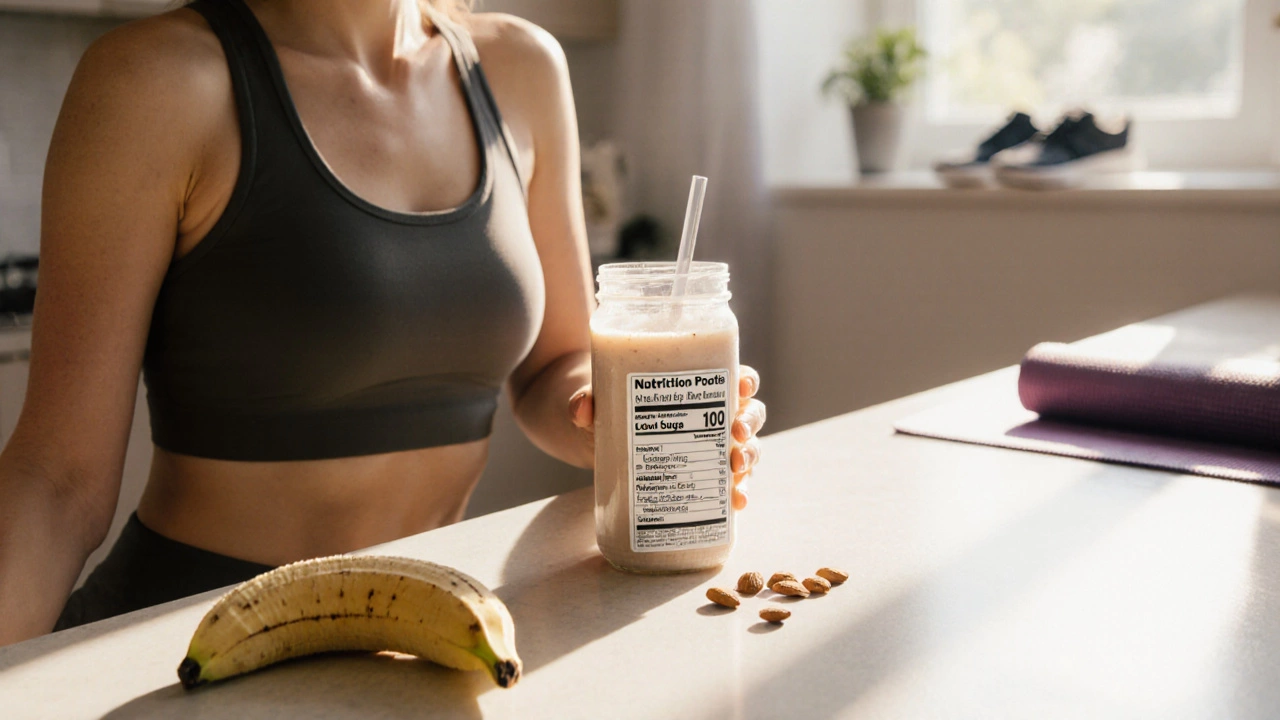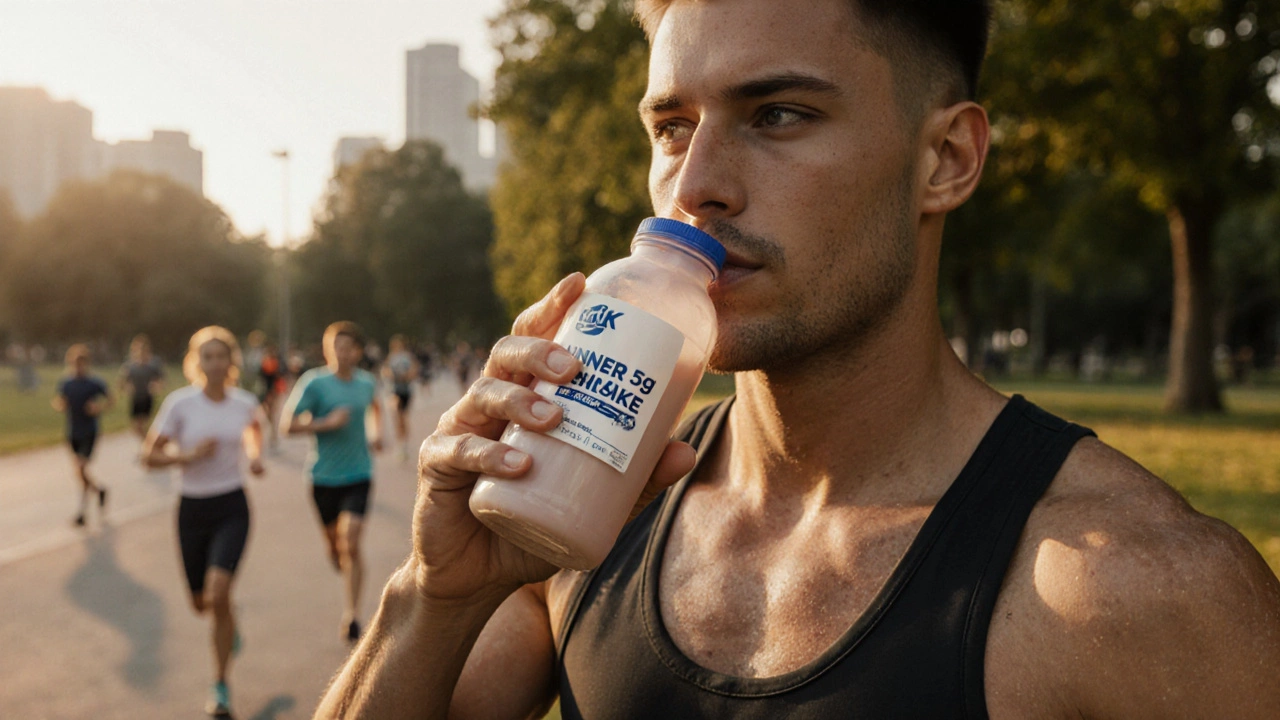
Protein Shake Calculator for Belly Fat Loss
Calculate Your Daily Protein Needs
Protein is essential for belly fat loss. This calculator helps determine how much protein you need daily based on your weight and activity level.
Your Protein Recommendations
Why this matters: Protein helps burn fat by boosting metabolism and reducing hunger. For belly fat loss, aim for 1.2-2.0g of protein per kg of body weight.
Protein Guide for Belly Fat Loss
Protein isn't magic but when used correctly, it's one of the most valuable tools for belly fat loss.
- Thermic Effect: Protein burns 15-30% of calories during digestion (vs 5-10% for carbs)
- Satiety: High-protein meals reduce hunger and calorie intake by 135+ calories/day
- Muscle Preservation: Protein helps maintain muscle mass during weight loss, boosting metabolism
- Best Timing: Distribute protein across meals (20-30g per meal) for maximum benefit
You’re trying to lose belly fat. You’ve cut back on sugar, started walking more, and maybe even done a few planks. But then you see it: a protein shake on the shelf with bold claims like "Melt Fat While You Sleep." You wonder-can this actually help? Or is it just another marketing trick?
The short answer? Yes, you can drink protein shakes while trying to lose belly fat-but only if you use them the right way. Protein shakes aren’t magic. They don’t zap fat on their own. But when paired with the right diet and lifestyle, they can be one of the most useful tools you have.
Why Protein Helps You Lose Belly Fat
Belly fat isn’t just annoying-it’s metabolically active. It’s linked to insulin resistance, inflammation, and higher risk for heart disease. Losing it isn’t about crunches. It’s about changing your body’s chemistry. And protein plays a big role.
When you eat protein, your body burns more calories digesting it than it does with carbs or fat. This is called the thermic effect of food. Protein can boost your metabolism by 15-30%, compared to 5-10% for carbs and 0-3% for fat. That means if you swap out a sugary snack for a protein shake, you’re burning extra calories just by eating it.
Protein also keeps you full longer. A 2023 study in the Journal of Nutrition found that people who ate 25-30 grams of protein at breakfast ate 135 fewer calories over the rest of the day. That’s like skipping a small muffin without even trying. And when you’re less hungry, you’re less likely to snack on chips, cookies, or sugary drinks-the real culprits behind belly fat.
Protein Shakes vs. Whole Foods: What’s the Difference?
Some people think protein shakes are just fancy liquid snacks. But they’re not the same as eating chicken, eggs, or lentils. Shakes are convenient, not superior.
Whole foods come with fiber, vitamins, minerals, and other nutrients your body needs. A chicken breast gives you zinc, iron, and B vitamins. A scoop of whey protein gives you… protein. That’s it. Unless it’s fortified, it won’t give you the full package.
So if you’re drinking protein shakes to replace meals, make sure you’re still getting veggies, healthy fats, and complex carbs elsewhere. A shake for breakfast with a banana and a handful of almonds? Great. A shake for breakfast, lunch, and dinner? That’s a recipe for nutrient gaps.
Also, not all shakes are created equal. Some have added sugar-up to 20 grams per serving. That’s like drinking half a can of soda. Always check the label. Look for under 5 grams of sugar and at least 20 grams of protein per serving. If it lists “maltodextrin” or “dextrose” near the top, put it back.
When Protein Shakes Actually Help You Lose Belly Fat
Protein shakes work best in three real-life situations:
- You’re skipping meals or eating too little. If you’re busy and end up eating fast food or skipping lunch, a shake can prevent muscle loss and keep your metabolism from slowing down.
- You’re strength training. When you lift weights or do resistance exercises, your muscles need protein to repair and grow. More muscle = higher resting metabolism = more fat burned even when you’re not working out.
- You’re struggling to hit your protein target. Most adults need 1.2-2.0 grams of protein per kilogram of body weight when losing fat. For a 70kg person, that’s 84-140 grams a day. It’s hard to hit that without planning. A shake can easily add 25-30 grams.
One woman I worked with in Auckland-let’s call her Lisa-was drinking a protein shake every morning after her walk. She didn’t change anything else at first. Within six weeks, her waist size dropped by 3 centimeters. Why? She’d replaced her sugary coffee drink with a low-sugar shake. That cut 180 calories a day. No magic. Just better choices.
When Protein Shakes Make Belly Fat Worse
Here’s the catch: protein shakes can sabotage your progress if you’re not careful.
If you’re drinking them on top of your regular meals, you’re adding calories-not replacing them. That’s like putting extra fuel in your car while trying to save gas. You’ll gain weight, not lose it.
And if you’re using shakes as a crutch to avoid real food, you’re missing out on the fiber and phytonutrients that help regulate hunger hormones. Fiber slows digestion, balances blood sugar, and reduces fat storage. Protein shakes don’t have fiber. So if you’re relying on them too much, you might feel hungry again within an hour.
Also, some people think protein shakes are “free” calories. They’re not. A 250-calorie shake still counts. If you’re eating 2,000 calories a day and adding a shake without cutting anything else, you’re now eating 2,250. That’s 1,750 extra calories a week. That’s half a kilo of fat.
How to Use Protein Shakes Right for Belly Fat Loss
Here’s a simple, no-nonsense plan:
- Choose wisely. Pick a shake with under 5g sugar, at least 20g protein, and no weird additives. Whey, casein, pea, or soy protein are all fine. Avoid “weight gainer” formulas-they’re full of carbs and sugar.
- Use it to replace a snack or one meal. Best times: breakfast, post-workout, or as a between-meal snack. Don’t add it to your three meals. Replace something.
- Pair it with fiber. Blend your shake with a handful of spinach, half an avocado, or a tablespoon of chia seeds. That adds volume, nutrients, and keeps you full.
- Track your calories for a week. Use a free app like MyFitnessPal. See how much you’re eating. If your shake pushes you over your daily goal, cut back on something else.
- Don’t rely on it forever. Use shakes as a tool, not a lifestyle. Once you’re used to eating protein-rich whole foods (eggs, fish, tofu, Greek yogurt), you won’t need them as much.

What About Plant-Based Protein Shakes?
If you’re vegan or lactose intolerant, plant-based shakes work just fine. Pea protein, brown rice protein, or soy blends can give you the same muscle-building power as whey. A 2022 meta-analysis in the Journal of the International Society of Sports Nutrition found no difference in fat loss or muscle retention between whey and pea protein when protein intake was matched.
But many plant-based shakes are lower in leucine-a key amino acid that triggers muscle repair. Look for blends that include pea, rice, and hemp, or choose one with added leucine. Avoid single-source plant proteins unless they’re fortified.
What Else Matters More Than Protein Shakes?
Let’s be real: protein shakes are a small piece of the puzzle. Belly fat comes from three things: too many calories, too much sugar, and too little movement.
Even the best protein shake won’t help if you’re drinking soda, eating takeout every night, and sitting all day. Focus on these first:
- Drink water instead of juice or sweetened coffee
- Get at least 8,000 steps a day
- Sleep 7-8 hours-poor sleep raises cortisol, which stores fat around your midsection
- Reduce processed carbs: bread, pasta, pastries, and sugary cereals
Once you’ve nailed those, then protein shakes can help you fine-tune the rest.
Final Thought: It’s Not the Shake. It’s the Habit.
People think losing belly fat is about finding the right supplement. It’s not. It’s about building habits that make fat loss automatic.
That means eating real food most of the time. Moving your body daily. Sleeping well. And using protein shakes only when they make life easier-not when they become a crutch.
If you’re already eating well and active, a shake won’t make you lose fat faster. But if you’re struggling to get enough protein without feeling hungry, it can be the difference between giving up and sticking with it.
Protein shakes aren’t the answer to belly fat. But they can be part of the solution-if you use them like a tool, not a shortcut.
Can I drink protein shakes every day to lose belly fat?
Yes, you can drink protein shakes every day as long as they fit into your daily calorie budget and replace something unhealthy-like a sugary snack or drink. But don’t use them to add extra calories. Stick to one per day, choose low-sugar options, and make sure you’re still eating whole foods like vegetables, lean meats, and healthy fats.
Will protein shakes make me bulky if I’m a woman?
No. Women don’t naturally produce enough testosterone to build large muscles from protein shakes alone. Protein helps preserve lean muscle while you lose fat, which actually makes you look leaner, not bulkier. If you’re not lifting heavy weights regularly, you won’t gain noticeable muscle size.
Are protein shakes better than whole foods for fat loss?
No. Whole foods like chicken, eggs, tofu, Greek yogurt, and legumes provide more nutrients, fiber, and satiety than protein shakes. Shakes are convenient, not superior. Use them to fill gaps, not replace meals entirely.
How much protein should I eat daily to lose belly fat?
Aim for 1.2 to 2.0 grams of protein per kilogram of body weight. For example, if you weigh 70kg, that’s 84-140 grams of protein per day. Spread it across meals-20-30 grams per meal-to keep your metabolism active and reduce hunger.
Can I drink protein shakes without working out and still lose belly fat?
Yes, you can. Protein helps control hunger and boosts metabolism even without exercise. But combining protein with movement-like walking, lifting, or dancing-will make fat loss faster and more sustainable. Exercise isn’t required, but it’s highly recommended.
